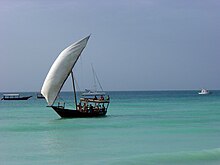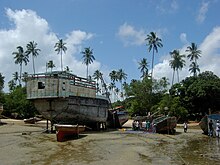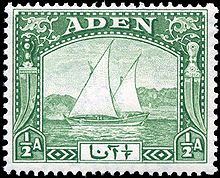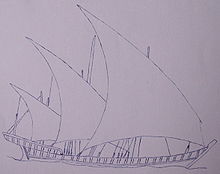This is an old revision of this page, as edited by R.Schuster (talk | contribs) at 13:58, 10 November 2009 (Reverted edits by Lamuhouse (talk) to last version by Arab League). The present address (URL) is a permanent link to this revision, which may differ significantly from the current revision.
Revision as of 13:58, 10 November 2009 by R.Schuster (talk | contribs) (Reverted edits by Lamuhouse (talk) to last version by Arab League)(diff) ← Previous revision | Latest revision (diff) | Newer revision → (diff)






A dhow (Arabic,داو) is a traditional Arab sailing vessel with one or more lateen sails. They are primarily used along the coasts of the Arabian Peninsula, Pakistan, India, and East Africa. Larger dhows have crews of approximately thirty, while smaller dhows typically have crews of around twelve.
History
Even to the present day Dhows make commercial journeys between the Persian Gulf and East Africa using sails as their only means of propulsion. Their cargo is mostly dates and fish to East Africa and mangrove timber to the lands in the Persian Gulf. Often they sail south with the monsoon in winter or early spring and back again to Arabia in late spring or early summer.
The term "dhow" is also applied to small, traditionally-constructed vessels used for trade in the Red Sea and the Persian Gulf area and the Indian Ocean from Madagascar to the Gulf of Bengal. Such vessels typically weigh 300 to 500 tons, and have a long, thin hull design.
Also, it is a family of early Arab ships that used the lateen sail on which the Portuguese likely based their designs for the caravel known to Arabs as sambuk, booms, baggalas, ghanjas, and zaruqs.
Navigation
For celestial navigation, dhow sailors have traditionally used the kamal. This observation device determines latitude by finding the angle of the Pole Star above the horizon.
Trade
Types of dhow
- Ghanjah - a large vessel with a curved stem and a sloping, ornately carved transom.
- Baghlah - the traditional deep-sea dhow
- Battil - featured long stems topped by large, club-shaped stem heads
- Badan - a smaller vessel requiring a shallow draught
See also
- Arab slave trade
- Dhoni - a lateen-sail rigged boat used in the Maldives
- Felucca - a lateen-sail rigged boat used on the Red Sea, eastern Mediterranean, and the Nile
References
Further reading
- Clifford W. Hawkins, The dhow: an illustrated history of the dhow and its world.
- Marion Kaplan, Twilight of the Arab dhow.
- Esmond Bradley Martin and Chryssee Perry Martin; foreword by Elspeth Huxley, Cargoes of the east : the ports, trade, and culture of the Arabian Seas and western Indian Ocean.
- Esmond BradleyMartin, The decline of Kenya's dhow trade.
- Mondfeld, Die arabische Dau
- Anthony Jack, Arab dhows.
- Henri Perrier, Djibouti's dhows.
- Tessa Rihards, Dhow building : survival of an ancient craft.
- Tom Vosmer, The durable dhow.
- Maritime activities of the Arab Gulf people and the Indian Ocean World in the 11th and 12th centuries
- Lloyd, The Navy and the Slave Trade
- Richard LeBaron Bowen, Essay on the tradition of painting eyes, known as oculi, on the bows of boats among mariners and fishermen from ancient times to the present. Found particularly in the Indian Ocean region.
- Hikoichi Yajima, The Arab dhow trade in the Indian Ocean : preliminary report
External links
| Types of sailing vessels and rigs | |||||||||||||||||
|---|---|---|---|---|---|---|---|---|---|---|---|---|---|---|---|---|---|
| Overviews | |||||||||||||||||
| Sailing rigs | |||||||||||||||||
| By sailing rigs | |||||||||||||||||
| Multihull vessels | |||||||||||||||||
| Naval and merchant sailing ships and other vessels (by origin date) |
| ||||||||||||||||
| Fishing vessels | |||||||||||||||||
| Recreational vessels | |||||||||||||||||
| Special terms | |||||||||||||||||
| Other types | |||||||||||||||||
| Related | |||||||||||||||||